I thought I’d take a break from the technical side of things and look back over the last year to see what kinds and quantities of jobs passed over my ShopBot table in a typical twelve months. I’m talking about the twelve months of 2008 – I’ve been trying to finish this column since January. This task is made easy since I keep a log of all the projects that get cut on my ShopBot. If you don’t keep such a log, I recommend getting a spiral notebook or 3-ring binder, and start taking notes each time you machine anything. It doesn’t have to be fancy, just jot down a few notes about the project, what cutter(s) you used, feed speeds and spindle speeds – anything pertinent about the toolpath – and most importantly anything you learned while working on that particular project. I find it especially useful to record move and ramp speed settings for anything that requires me to play around with those settings to get the results I’m seeking. Then the next time a similar situation comes up I can refer to those previous projects and have a good starting point to work from. You may think you’ll remember all those details that seem so important while the job is at the forefront of your attention, but believe me, once a few more projects have come and gone, you’ll be hard pressed to remember anything about what you did four or six months ago. It’s like trying to remember what you ate for lunch two weeks ago last Tuesday. I make a point to highlight any particularly hard-learned lessons (read: mistakes) to help ensure that I don’t let history repeat itself. Even if you never go back to re-read those notes, just the effort of writing them down re-enforces the lesson.
Anyway, over the course of last year, I count around 40 projects of various sizes that I machined on my ShopBot, ranging from V-carving a single line of text into a single piece of wood for a fellow that was building a podium for his church to cutting out 450 sheets of melamine for my closet customer over the course of the year. Technically the closet jobs were several dozen individual projects, but I’m counting them as one so as not to skew the numbers too much. In between those extremes, I was able to divide the other 38 projects into six broad categories, beginning with my bread and butter cabinetry jobs, of which there were about a dozen. Now I know for a cabinet shop to only do one cabinet job a month doesn’t seem like much, but remember I work mostly alone, and a large kitchen project can keep me going for several weeks. For better or worse, most of my cabinetry jobs last year were much smaller than that, and only three were full kitchens. The others included a home office, three bathroom vanity projects plus a bathroom built-in, a wall-to-wall dining room built-in (my first project using hickory in 25 years of cabinetmaking), some bookcases, a reception desk (I just cut the parts for another cabinetmaker), and modifications to an entertainment center that I first built 15 years ago that the client wanted to update to accommodate a new flat screen TV. For all these projects the ShopBot was used to cut all the sheet materials, including drilling the holes for hardware and adjustable shelves.
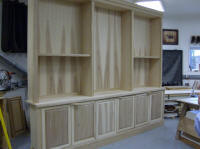
Only a few of my projects get fully assembled in the shop before being delivered. This wall unit was my first ever project made of Hickory.
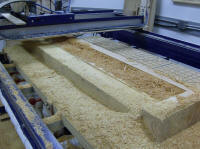
This 100-year-old slab of Heart Pine was still so wet with pitch inside that the chips stuck to everything, including the rails and wheels, making it a challenge to machine.
The next most significant group of projects I worked on last year were those that consisted primarily of machining blocks of solid wood. As I mentioned, these are pretty broad categories, and this one ranged from cutting some disks out of a piece of Bubinga to working on my own still-in-progress dining room table, which I’m building out of four large oak slabs gleaned from a huge tree that fell over in my neighborhood a few years ago. I had already sold and processed the other half of the eight slabs that the giant tree yielded for a desk top and a couple of tables, and I decided I could get creative with the remaining pieces. That project alone involved almost 3 dozen machining operations, but unfortunately after spending a couple of weeks on it early in the year I had to put it aside to get some paying jobs done, and it’s been in storage ever since. I am determined to complete it this year – and then write a column about it. The other solid wood machining projects included routing logos into twenty four-inch-thick Cypress slabs for the backs of some park benches, milling out a two-inch-deep pocket in a large piece of re-claimed Heart Pine for a mantle (the recess was so the slab could fit over an existing two-inch thick mantle) and surfacing a couple of Ambrosia Maple slabs for a reception desk for a State College in north Georgia. The architect liked those slabs so much he commissioned a small table using a leftover piece of one of the slabs as a gift to the project manager, which necessitated my having to turn some tapered legs and rails. I finally figured out how to mount my small lathe to the end of my ShopBot table so I could turn the parts with the ShopBot. Definitely one of those “why didn’t I do this sooner?” moments.
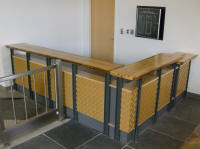
These slabs of Ambrosia Maple were some of the most beautiful pieces of wood I’ve ever had the pleasure to work with. Watching them being sliced out of the log was a real treat. Necessity is the mother of invention. I finally figured out how to attach my lathe to the end of my table.
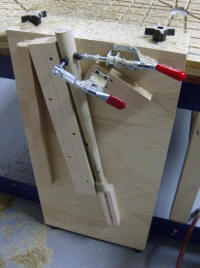
I had made this jig some time ago to drill leg ends for T-nuts and levelers; with minor modifications it made easy work of an otherwise difficult task.
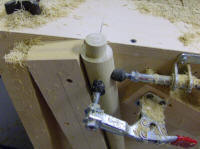
Need some angled tenons on the ends of tapered legs? No problem. The finished table. There is an inscription on the underside, V-carved of course.
The third broad category was what I’d consider craft projects. These also were mostly solid wood machining but more akin to fabricating intricate parts than machining large single pieces of wood. The first was a fairly complex pair of multi-tiered jewelry storage carousels for a large bathroom project that I had completed in late 2007. They turned out pretty nicely, but were way too time-consuming considering I made them as a gift to the client as a thank you for commissioning the bathroom project as well as one of the larger kitchen projects I’ve ever fabricated. No regrets, but I may try to be a little stingier with my free time in the future. I also made a wine rack insert for a kitchen drawer, and a couple of fairly quick projects as gifts for my lovely bride of almost 20 years. While these don’t pay off monetarily, the fringe benefits make them more than worth the trouble. The other notable intricate wood project from last year was to create four sets of interlocking curved mullions for some glass kitchen cabinet doors for my largest kitchen job of the year. I used the ShopBot to cut out curved plywood forms which I used both to glue up the bent laminations and also to hold the laminated workpieces to the table for further machining – another project that may be worthy of its own column in the near future.
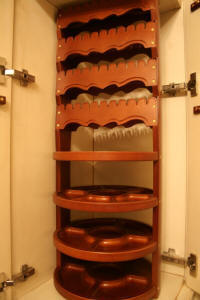
Nice but not profitable. At least I got to keep the pictures.
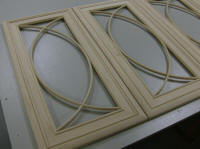
These curved mullions were one of the more challenging tasks I tackled last year on the ShopBot. The door frames were outsourced along with the rest of the doors for the project.
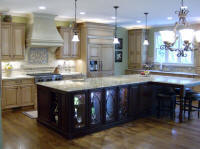
The completed kitchen.
Next up are a few quick projects that each took less than half an hour from start to finish. A template out of ½” MDF for a woodworker friend, cutting a glued up blank into an oval for a mirror frame, a quickly V-carved sign for another buddy who has since bought his own ShopBot, and routing the centers out of four kitchen cabinet doors for glass panels are all good examples. While I can’t make a living doing these little items, an extra 50 or 75 bucks once in a while doesn’t hurt, and, after being immersed in a large cabinet project for several weeks, it’s nice to be able to start and finish a project in less than an hour and get paid right away.
The fifth group from the 2008 Hall of Fame includes a wide variety of jobs that just don’t fit into a real category. One was a set of large wall mounted plaques for a local country club. The job consisted mostly of applying moldings to plywood blanks, but since there were only one or two of each style and the moldings that had been specified were special order items I used the Extruder Virtual Tool to make some of the more complex moldings on the ShopBot. Although they take some time to rout, using a very small stepover to minimize sanding, they didn’t take that long to draw, toolpath and set up for cutting, and I was working on other tasks while the machine did its thing. Each profile saved me a set-up fee from the molding supplier. I ran some of the simpler profiles on the router table and saved the ShopBot for those profiles that I couldn’t make with my collection of router bits. Another oddball project was a large venthood cover for a kitchen renovation, with curved, sloping surfaces on the sides and front. The ShopBot cut the curved ribs – which I then covered with bending plywood – as well as the simpler parts that made up the structure of the finished piece. I also cut several other projects that used a bunch of curved plywood parts, including sets for my kids’ school play, a ten-foot-tall plywood “tree” for the school’s lobby, and a 20-foot long S-curved island for my own kitchen. One of the great benefits of owning a ShopBot is the ability to design almost anything without worrying about how to cut out complex parts, and when creating projects for myself, I enjoy total design freedom since I don’t have to please a customer’s tastes. Fortunately my wife appreciates most of my designs, and after waiting twelve years for a new kitchen she wasn’t about to complain when I finally came up with something.
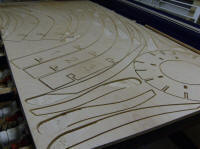
Nesting curved parts like this is always a trade-off between time and material yield. Now that PartWorks 2.0 includes nesting, a lot of that tedium has been eliminated.
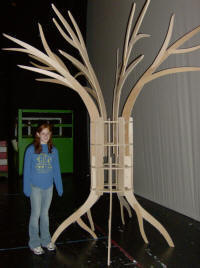
The assembled prop piece for the school’s graduation ceremony.
The final few projects in my informal survey don’t even fit into the “other” category. I spent a week in Florida building a vacuum table for a new ShopBotter and helping him get up to speed with his machine. It was the first prototype of a new manifold and valve design for multi-zone tables, which I plan to develop and offer to other CNC owners. (Don’t hold your breath though; it’s taken me six months just to write this column, so the R&D required will likely take place over an extended period). I’ve cut the parts to replace my existing PVC plumbing and valves with this new system, but since there’s no immediate payback and the transition will mean taking my existing table out of service for a few days, it will have to wait until the time is right. I also had my first experience cutting “plastic” lumber, machining some curved parts for my son’s Eagle Scout project. Not surprisingly, like most soft plastics, the stuff machined pretty easily. Following Gary Campbell’s lead, I made a jig for producing dovetailed drawers with my ShopBot. The jig itself was time-consuming to make, but once it was set up, I could machine a set of dovetails in a couple of minutes. Unfortunately, the time and cost of preparing the wood and finishing the assembled drawers means I’ll probably continue to outsource my dovetailed drawers, but the jig may prove useful in the future for other machining operations.
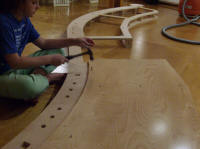
Kitchen in progress. I can’t even begin to explain it.
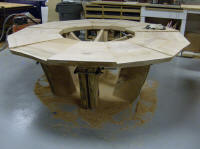
This twelve-sided, live-edge table will be 7’ across, if I ever find the time to complete it.